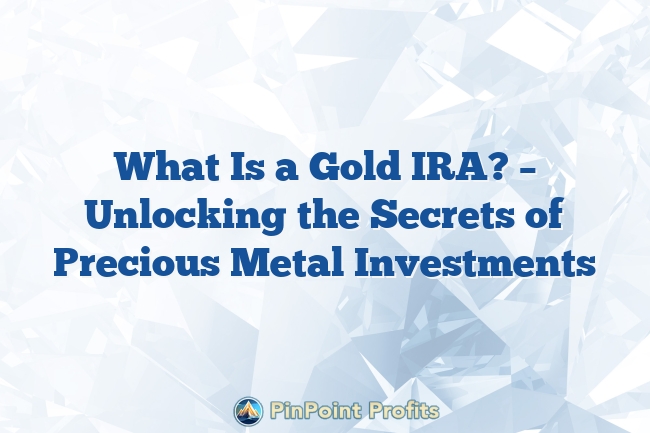If you're looking to understand what a Gold IRA is, you're in the right spot. This guide will walk you through everything you need to know about Gold IRAs, from setting one up to understanding the tax implications. Whether you're considering diversifying your retirement portfolio or seeking a hedge against inflation, this is the place to start.
| Key Points | Description |
|---|---|
| Definition | A Gold IRA is a self-directed IRA that holds physical gold and other precious metals |
| Benefits | Inflation protection, portfolio diversification, hedge against economic uncertainty |
| Setup Process | Choose a custodian, fund the account, purchase IRS-approved gold |
| Tax Implications | Tax-deferred contributions, potential tax liabilities on distributions |
| Risks | Gold price volatility, custodian fees, storage costs |
What is a Gold IRA?
A Gold IRA is a type of self-directed IRA that allows you to invest in physical gold and other precious metals. Unlike traditional IRAs, which typically hold paper assets like stocks and bonds, a Gold IRA holds IRS-approved gold, such as gold bullion and gold coins.
This type of IRA offers a unique way to diversify your retirement portfolio with a tangible asset. Gold IRAs are often considered a safe-haven asset, providing a hedge against inflation and economic uncertainty.
They offer the potential for portfolio diversification, as gold often moves independently of stocks and bonds. This makes them an attractive alternative investment for those looking to preserve their wealth over the long term.

Benefits of Investing in Precious Metals
Investing in precious metals like gold and silver offers several benefits. One of the primary advantages is inflation protection. Gold and other precious metals have historically maintained their value over time, making them a reliable store of wealth.
This is particularly important in times of economic uncertainty when traditional paper assets may lose value. Another benefit is the potential for portfolio diversification.
By adding precious metals to your retirement portfolio, you can reduce your overall risk and increase your chances of achieving long-term financial stability. Precious metals are also considered a safe-haven asset, providing a level of security that other investments may not offer.
How to Set Up a Gold IRA
Setting up a Gold IRA involves several steps. First, you'll need to choose a reputable IRA custodian who specializes in precious metals IRAs. The custodian will help you navigate the process and ensure that your investment complies with IRS regulations.
Next, you'll need to fund your Gold IRA. This can be done through a rollover from an existing IRA or 401(k), or by making a new contribution.
Once your account is funded, you can begin purchasing IRS-approved gold and other precious metals. It's important to work with a custodian who offers custodial services and has experience in handling gold-backed IRAs.
Choosing the Right Custodian
Choosing the right custodian is crucial when setting up a Gold IRA. The custodian is responsible for managing your account and ensuring compliance with IRS regulations. Look for a custodian with a strong reputation and experience in handling precious metals IRAs.
Consider the fees and costs associated with the custodian's services. Some custodians charge a flat fee, while others charge a percentage of your account balance.
It's important to understand these fees and how they will impact your investment. Additionally, ensure that the custodian offers secure storage options for your physical gold, such as a precious metals depository.
Tax Implications of Gold IRAs
Gold IRAs offer several tax advantages, but it's important to understand the implications. Contributions to a Gold IRA are typically tax-deferred, meaning you won't pay taxes on the money until you withdraw it in retirement.
This can provide significant tax savings over time. However, there are also potential tax liabilities to consider.
For example, if you take a distribution from your Gold IRA before age 59½, you may be subject to a 10% early withdrawal penalty. Additionally, the value of your gold holdings may be subject to capital gains tax when you sell them.
Storage Options for Precious Metals
When investing in a Gold IRA, you'll need to consider storage options for your physical gold. The IRS requires that gold held in an IRA be stored in an approved depository. This ensures that your investment is secure and compliant with IRS regulations.
There are several types of storage options available, including segregated and non-segregated storage. Segregated storage means your gold is stored separately from other investors' assets, while non-segregated storage means your gold is stored with other investors' assets.
Each option has its own advantages and disadvantages, so it's important to choose the one that best fits your needs.
Risks Involved in Gold IRAs
While Gold IRAs offer several benefits, there are also risks to consider. One of the primary risks is the volatility of the gold spot price. The value of gold can fluctuate significantly, which can impact the value of your investment.
Another risk is the potential for fraud or mismanagement by the custodian. It's important to choose a reputable custodian with a strong track record to minimize this risk.
Additionally, there are fees and costs associated with Gold IRAs, which can impact your overall returns. It's important to fully understand these risks before investing in a Gold IRA.
Comparing Gold IRAs to Traditional IRAs
Gold IRAs and traditional IRAs each have their own advantages and disadvantages. One of the primary differences is the type of assets held in each account. Traditional IRAs typically hold paper assets like stocks and bonds, while Gold IRAs hold physical gold and other precious metals.
Another difference is the potential for portfolio diversification. Gold IRAs offer a unique way to diversify your retirement portfolio with a tangible asset, while traditional IRAs may be more susceptible to market volatility.
However, traditional IRAs may offer more liquidity, as they can be easily converted to cash. It's important to consider these differences when deciding which type of IRA is right for you.
How to Rollover an Existing IRA to a Gold IRA
Rolling over an existing IRA to a Gold IRA is a straightforward process. First, you'll need to choose a reputable IRA custodian who specializes in precious metals IRAs. The custodian will help you navigate the rollover process and ensure compliance with IRS regulations.
Next, you'll need to initiate the rollover by contacting your current IRA provider. They will transfer the funds from your existing IRA to your new Gold IRA.
Once the funds are transferred, you can begin purchasing IRS-approved gold and other precious metals. It's important to work with a custodian who offers custodial services and has experience in handling gold-backed IRAs.
Understanding Fees and Costs
When investing in a Gold IRA, it's important to understand the fees and costs associated with the account. These can include:
- Setup fees
- Annual maintenance fees
- Storage fees
- Transaction fees
Some custodians charge a flat fee, while others charge a percentage of your account balance. It's important to fully understand these fees and how they will impact your investment.
Additionally, there may be transaction fees associated with purchasing and selling gold. It's important to factor these costs into your overall investment strategy to ensure that you achieve your financial goals.
Regulations and Compliance
Gold IRAs are subject to strict IRS regulations and compliance requirements. It's important to work with a reputable custodian who understands these regulations and can ensure that your investment is compliant. This includes ensuring that your gold is stored in an approved depository and that your account is properly managed.
Additionally, there are contribution limits and distribution rules that apply to Gold IRAs. It's important to understand these rules and how they will impact your investment.
Working with a knowledgeable custodian can help ensure that your Gold IRA is compliant with all IRS regulations.
Long-term Investment Strategies
When investing in a Gold IRA, it's important to have a long-term investment strategy. This includes understanding the potential risks and rewards of investing in gold and other precious metals. It's also important to consider your overall financial goals and how a Gold IRA fits into your retirement portfolio.
One strategy is to use a Gold IRA as a hedge against inflation and economic uncertainty. Gold has historically maintained its value over time, making it a reliable store of wealth.
Another strategy is to use a Gold IRA as a way to diversify your portfolio and reduce overall risk. By adding precious metals to your retirement portfolio, you can increase your chances of achieving long-term financial stability.
The Role of Gold in a Balanced Portfolio
Gold plays a unique role in a balanced investment portfolio. As a tangible asset, it offers a level of security that paper assets like stocks and bonds can't match. Gold is often seen as a safe-haven asset, particularly during times of economic uncertainty or market volatility.
Including gold in your portfolio can help to reduce overall risk and provide a hedge against inflation. Many financial advisors recommend allocating a portion of your portfolio to gold, typically around 5-10%, depending on your individual financial goals and risk tolerance.
Gold IRA vs. Physical Gold Ownership
While both Gold IRAs and physical gold ownership offer exposure to precious metals, there are some key differences. A Gold IRA allows you to own gold within a tax-advantaged retirement account, potentially offering significant tax benefits.
Physical gold ownership, on the other hand, gives you direct possession of the gold, but without the tax advantages of an IRA. With a Gold IRA, the gold is stored in an approved depository, while physical gold ownership requires you to handle storage and security yourself.
The Process of Buying Gold for Your IRA
Buying gold for your IRA involves several steps:
- Choose an IRA custodian specializing in precious metals
- Open and fund your Gold IRA account
- Select the type of gold you want to purchase (coins, bars, etc.)
- Place an order through your custodian
- Arrange for secure storage at an approved depository
It's important to work with a reputable dealer and ensure that all gold purchases meet IRS requirements for purity and form.
Understanding Gold Market Dynamics
The gold market is influenced by a variety of factors, including global economic conditions, geopolitical events, currency fluctuations, and supply and demand dynamics. Understanding these factors can help you make more informed decisions about your Gold IRA investments.
Gold prices tend to rise during times of economic uncertainty or inflation, making it a popular hedge against these risks. However, like any investment, gold prices can be volatile in the short term.
It's important to take a long-term perspective when investing in gold and to consider it as part of a diversified investment strategy.

Conclusion
Investing in a Gold IRA can be a valuable addition to your retirement strategy. It offers unique benefits such as inflation protection, portfolio diversification, and a hedge against economic uncertainty. However, it's important to understand the risks and costs associated with this type of investment.
By working with a reputable custodian and developing a long-term investment strategy, you can maximize the potential benefits of a Gold IRA. Whether you're looking to preserve your wealth or achieve financial stability, a Gold IRA can be a powerful tool in your retirement planning arsenal.
What are the IRS regulations regarding Gold IRAs?
The IRS has strict regulations for Gold IRAs, including requirements for gold purity, approved storage facilities, and contribution limits. It's crucial to work with a knowledgeable custodian to ensure compliance.
Can I hold other precious metals in my Gold IRA?
Yes, in addition to gold, you can hold silver, platinum, and palladium in your precious metals IRA, as long as they meet IRS purity standards.
What happens if I want to take a distribution from my Gold IRA?
You can take distributions in the form of physical gold or cash. However, early withdrawals before age 59½ may incur penalties, and you'll need to pay taxes on the distribution.

